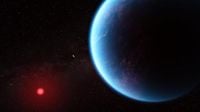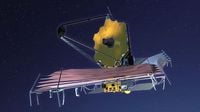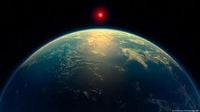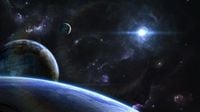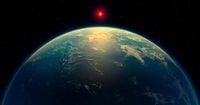In a groundbreaking announcement on April 17, 2025, a team of astronomers from Cambridge University, led by Nikku Madhusudhan, presented what they claim to be the strongest evidence yet of life beyond Earth. This revelation centers on K2-18b, a Neptune-like exoplanet located 120 light-years away in the constellation Leo, which is approximately two and a half times the size of Earth.
Utilizing the advanced capabilities of the James Webb Space Telescope, the researchers detected two significant gases in the atmosphere of K2-18b: dimethyl sulfide (DMS) and dimethyl disulfide (DMDS). On our planet, these gases are predominantly produced by microbial life, such as marine phytoplankton and certain bacteria. Madhusudhan expressed his excitement, stating, "This is a revolutionary moment. It is the first time humanity has seen potential biosignatures on a habitable planet." He believes that K2-18b could be enveloped by a temperate ocean, conducive to the existence of life.
Despite the excitement surrounding this discovery, the scientific community remains cautious. Ignasi Ribas, the director of the Institute for Space Studies of Catalonia, described the findings as "interesting" but emphasized that they do not yet confirm the existence of life. He pointed out that the results stem from a single research group and need to be replicated by others to gain credibility. Ribas noted that the study was published in The Astrophysical Journal Letters, a lesser-known scientific journal, suggesting that a more prestigious publication would have been appropriate for such significant claims.
This isn't the first time K2-18b has made headlines. In 2019, researchers announced the presence of water on the planet, which was later revealed to be methane. In 2023, weak signals of DMS were detected, but the current findings show a much stronger presence of these gases. Ribas cautioned that the presence of DMS could potentially be explained by non-biological processes, urging the scientific community to remain skeptical until further evidence is gathered.
K2-18b, which has a mass 8.6 times that of Earth and a diameter approximately 2.6 times greater, orbits its star within the "habitable zone," where conditions may allow for liquid water to exist. The planet's orbit around a red dwarf star is completed every 33 days. Madhusudhan theorizes that if K2-18b is indeed covered by warm oceans and possesses a hydrogen-rich atmosphere, it could support microbial life similar to that found in Earth's oceans. He acknowledged the need for more observations, stating, "First, we need to repeat the observations two or three times to ensure that the signal we observe is robust and increase the significance of the detection to the point where the odds of a statistical fluke are less than about one in a million."
However, the study's findings indicate only a "3 sigma" probability of biological activity, which many experts argue is insufficient for making definitive claims about extraterrestrial life. David Clements, an astrophysicist at Imperial College London, expressed that a solid claim for the existence of life would require a detection of at least "5 sigma." He stated, "This is really interesting stuff and, while it does not yet represent a clear detection of dimethyl sulfide and dimethyl disulfide, it is a step in the right direction. To get to a solid claim for the existence of life on this planet, we’d need to have a solid detection, >5 sigma, a clear demonstration that this is a biomarker and not some other molecular species masquerading as a biomarker."
Stephen Burgess, a group leader at the University of Cambridge, elaborated on the significance of the sigma levels, explaining that a "3 sigma" result suggests that the observed differences in the experiment are notable enough to exclude the possibility of a chance finding in rare cases, while a "5 sigma" result would provide a much stronger assertion against random chance.
As the James Webb Space Telescope continues its observations, experts remain hopeful that more definitive evidence of extraterrestrial life could surface. Madhusudhan estimated that only an additional 16 to 24 hours of observations with the telescope would be needed to confirm their findings. He expressed optimism about the potential for discovering life, stating, "If we confirm that there is life on K2-18b, we would essentially confirm that life is very common in the galaxy." However, he reiterated the importance of skepticism in scientific inquiry, emphasizing that rigorous testing and validation are crucial before making any definitive claims.
The search for extraterrestrial life has been a longstanding quest for scientists, with K2-18b emerging as a prime candidate due to its unique characteristics. The discovery of DMS and DMDS has reignited interest in the possibility of life beyond our planet. Still, as Ribas and other experts have pointed out, the scientific community must proceed with caution, ensuring that any conclusions drawn are based on robust evidence rather than excitement alone.
As astronomers continue to analyze K2-18b and other similar exoplanets, the hope remains that the James Webb Space Telescope will provide further insights into the potential for life beyond Earth. The findings from K2-18b may be a pivotal moment in our understanding of the universe and our place within it, but the journey to confirm the existence of extraterrestrial life is far from over.
